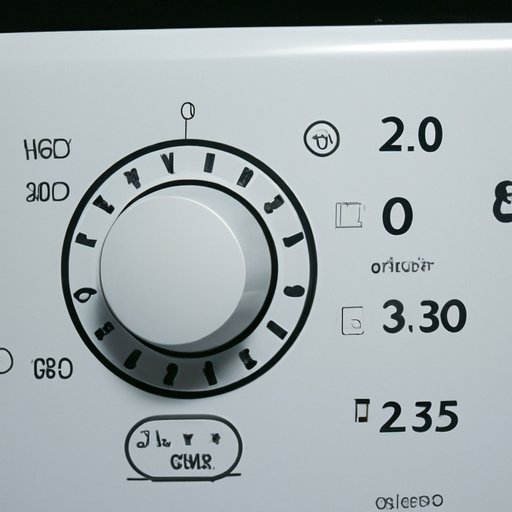Introduction
Dryers are essential appliances for many homes, but do you ever wonder how hot they actually get? Understanding the science behind dryer heating is important to ensure that your clothes come out of the dryer free from wrinkles and damage. In this article, we’ll explore how hot a dryer gets, the pros and cons of high heat levels, and what to look for in a high-performing dryer. We’ll also provide tips for keeping your dryer running at optimal temperatures and understanding the different types of dryers and their heat outputs.
Exploring the Science Behind Dryer Heating: How Hot Does a Dryer Get?
Before we can answer the question of how hot a dryer gets, it’s important to understand some basics about heat transfer in dryers. Heat transfer is the process by which energy is transferred from one object to another, and in dryers, it occurs when the heated air inside the drum is circulated around the laundry. This air absorbs moisture from the wet clothes and is then vented outside the machine. As the air circulates, the temperature gradually increases until it reaches the desired level.
Different types of heat sources are used in dryers to generate the heat needed for drying. The most common type of heat source is an electric element, which is typically located at the bottom or back of the dryer. Natural gas and propane are also used in some models. Each of these heat sources produces different levels of heat, so it’s important to consider this when shopping for a dryer.
The temperature of a dryer can vary depending on the type of heat source and the settings chosen. Generally speaking, electric dryers tend to produce more heat than gas dryers, with temperatures ranging from 140°F (60°C) to 180°F (82°C). Gas dryers tend to have lower temperatures, usually between 120°F (49°C) and 150°F (66°C).
The Pros and Cons of Dryer Heat: Is It Too Hot or Just Right?
High heat levels in a dryer can be beneficial in some cases, as it helps to reduce drying times and eliminate wrinkles and static cling. However, too much heat can cause fabrics to shrink or fade, and in some cases, it can even lead to fire hazards. To ensure that your clothes are being dried safely and effectively, it’s important to understand the pros and cons of high heat levels.
Benefits of High Heat Levels
Higher heat levels in a dryer can help to reduce drying times, especially for bulky items like towels and blankets. The higher temperatures also make it easier to remove wrinkles and static cling from fabrics. Additionally, high heat levels can help to kill bacteria and dust mites, making them a great choice for people with allergies or sensitive skin.
Risks of Excessive Heat
While high heat levels can be beneficial in some cases, they can also be dangerous. Too much heat can cause fabrics to shrink or fade, and it can also increase the risk of fires in some cases. It’s important to check the manufacturer’s instructions to make sure that you’re using the correct temperature settings for your specific dryer.
What to Look for in a High-Performing Dryer: Temperature Settings and More
When shopping for a dryer, there are several features to consider to ensure that you’re getting a high-performing model. Temperature settings and controls are particularly important, as they will determine how hot the dryer gets. Many models offer adjustable temperature settings, allowing you to choose the ideal setting for your needs. Additionally, some models offer sensors that automatically adjust the temperature based on the load size and moisture level.
It’s also important to consider other features, such as the drum size, spin speed, and energy efficiency rating. Larger drums allow for more efficient drying, while higher spin speeds can help to reduce drying times. Energy efficiency ratings can help you to identify models that use less energy, saving you money on your utility bills in the long run.

Tips for Keeping Your Dryer Running at Optimal Temperatures
In order to keep your dryer running at optimal temperatures, it’s important to regularly clean and maintain the machine. Regularly cleaning the lint filter and venting system can help to prevent fires, while checking the temperature settings on a regular basis can help to ensure that your clothes are being dried at the correct temperatures. Additionally, adjusting the temperature settings as needed can help to ensure that your clothes are not being over-dried or under-dried.
Understanding the Different Types of Dryers and Their Heat Outputs
Another important factor to consider when shopping for a dryer is the type of dryer you’re looking for. Gas and electric dryers both have their own unique advantages and disadvantages, and the type of dryer you choose will largely depend on your individual needs. In terms of heat output, gas dryers tend to have lower temperatures than electric dryers, although the exact temperature will vary depending on the model.
If you’re looking for a dryer with higher temperatures, an electric dryer may be the best option. Electric dryers tend to have higher temperatures, with some models reaching up to 180°F (82°C). However, it’s important to note that these higher temperatures can cause fabrics to shrink or fade if not used correctly.
Conclusion
Dryers are essential appliances for many homes, but how hot do they really get? Understanding the science behind dryer heating is important to ensure that your clothes come out of the dryer free from wrinkles and damage. In this article, we explored how hot a dryer gets, the pros and cons of high heat levels, and what to look for in a high-performing dryer. We also provided tips for keeping your dryer running at optimal temperatures and understanding the different types of dryers and their heat outputs.


